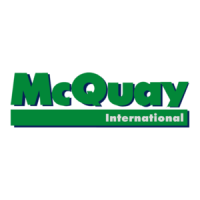94 OM Centrif Micro ΙΙ-5
Sequence of Operation
Unit Operation
The following sequence of events describes a typical WDC start and second compressor staging
process. All the contingency features of the code are not necessarily included. The purpose of this
document is to provide the operator with some insight into how the centrifugal chiller distributed
control process works to start and stage compressors.
The code was laid out to control four chillers with four compressors on each chiller. The polling
routine described below searches for all possible compressors (16 total), the code works the same
rather in a standalone WSC, or in a Dual (2 chiller) WDC setup. The Max Comp On setpoint is
used to limit the number of compressors that can run at one time (not the number being polled).
Chiller Starting
1. When the Unit state is switched to Auto, the compressors on a dual, or multi-compressor setup,
poll each other (1 to 2 minutes) to determine which will be NEXT_ON. The outcome of the
NEXT_ON search is determined by the Staging Sequence selected by the operator. Only one
compressor at a time can be selected to be NEXT_ON, and only compressors without active
alarms. The NEXT_ON status is indicated by lighting the right arrow button on that
compressor's controller keypad. If the NEXT_ON compressor has Start-to-Start or Stop-to-
Start timers running, the chiller will wait for them to clear.
2. When the Unit controller receives the NEXT_ON flag from one of it’s compressors, it will
start it’s Evap Pump (Evap Start State) and wait for the Recirculation time, at a minimum, then
it will wait "till the end of time" for the flow switch to close. When flow is confirmed, the
Evap State will switch to Run.
3. Approximately one min after NEXT_ON is set in the compressor, the compressor will look at
the Evap LWT to determine if Start-Delta-T has been exceeded. If so the Stage-Up-Now flag
is set, and if Evap State equals Run, the compressor start sequence will begin [Comp Start (oil
pump) state].
4. When the required net oil pressure is achieved, the compressor will transition to PreLube state
and when the Vanes_Closed switch is made (compressor cleared to start) the Unit controller
will start the Condenser Pump.
If the Vanes_Closed switch is not made within the Prelube time plus 30 seconds, a Vanes-
Open-No-Start alarm is declared.
If condenser flow is not established within a time period after the vanes closed signal, a
Condenser Flow alarm is declared. The time period is equal to the Prelube time plus 30
seconds. Note: It is possible for the Prelube state to successfully run for twice the Prelube
time plus 60 seconds, and not create an alarm.
While running, if flow is lost and a secondary pump is available, the primary pump output will
be turned off and the secondary pump output turned on. The time required is one-half of the
flow proof set point value.
5. In order to transition from Prelube to Compressor run state the following flags must be set:
Unit_State_Auto, Evap_State_Run, Cond_State_Run, Vanes_Closed, and Prelube timer
expired. Given this the lead compressor will start.
Compressor Staging
1. If the Normal (default) Staging Sequence on a WDC chiller is selected, and a compressor (the
lead) has just started, the lag compressor’s polling routine will declare it as the NEXT_ON
compressor.

